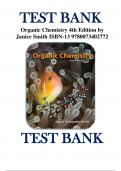TEST BANK
Organic Chemistry 4th Edition by
Janice Smith ISBN-13 9780073402772
TEST BANK
, Chapter 1: Structure and Bonding
1. What is the ground-state electronic configuration of a carbon atom?
A) 1s2, 2s2, 2p5 B) 1s2, 2s2, 2p2 C) 1s2, 2s2, 2p6 D) 1s2, 2s2, 2p4
2. What is the ground-state electronic configuration of a fluorine atom?
A) 1s2, 2s2, 2p2 B) 1s2, 2s2, 2p3 C) 1s2, 2s2, 2p4 D) 1s2, 2s2, 2p5
3. What is the ground-state electronic configuration of a magnesium cation (Mg2+)?
A) 1s2, 2s2, 2p6 C) 1s2, 2s2, 2p6, 3s2
B) 1s2, 2s2, 2p6, 3s1 D) 1s2, 2s2, 2p6, 3s2, 3p2
4. What is the ground-state electronic configuration of a chlorine anion (Cl—)?
A) 1s2, 2s2, 2p6 C) 1s2, 2s2, 2p6, 3s2, 3p5
B) 1s2, 2s2, 2p6, 3s2, 3p6 D) 1s2, 2s2, 2p6, 3s2, 3p4
5. Which of the following statements about valence electrons is true?
A) They are the most tightly held electrons.
B) They do not participate in chemical reactions.
Page 1
, Chapter 1: Structure and Bonding
C) They are the outermost electrons.
D) They reveal the period number of a second-row element.
6. Which of the following statements about bonding is true?
A) Covalent bonds result from the transfer of electrons from one element to another.
B) Ionic bonds result from the transfer of electrons from a metal to a non-metal.
C) Ionic bonds result from the sharing of electrons between two non-metals.
D) Covalent bonds result from the sharing of electrons between two metals.
7. Which of the following would you expect to have ionic bonds?
A) CO B) FBr C) NF3 D) NaCl
8. Which of the following molecules has nonpolar covalent bonds?
A) HCl B) N2 C) CHCl3 D) NO
9. Which of the following molecules contain both covalent and ionic bonds?
A) I, II B) I, IV C) II, III D) II, IV
10. Arrange the following bonds in decreasing order of ionic character, putting the most
ionic first.
A) I > II > III > IV C) IV > III > II > I
B) IV > II > I > III D) IV > II > III > I
11. Which of the following statements correctly describes the typical number of bonds for
carbon, nitrogen, and oxygen in most neutral organic molecules?
A) Carbon forms 4 covalent bonds, nitrogen forms 2 covalent bonds and oxygen forms
3 covalent bonds.
B) Carbon forms 4 covalent bonds, nitrogen forms 3 covalent bonds and oxygen forms
2 covalent bonds.
Page 2
, Chapter 1: Structure and Bonding
C) Carbon forms 4 covalent bonds, nitrogen forms 5 covalent bonds and oxygen forms
2 covalent bonds.
D) Carbon forms 4 covalent bonds, nitrogen forms 5 covalent bonds and oxygen forms
4 covalent bonds.
12. Which is not an acceptable Lewis structure for the anion CH2NCO—?
A) I B) II C) III D) IV
13. Which of the following Lewis structures is correct?
A) I B) II C) III D) IV
14. Which of the following Lewis structures is correct?
A) I, II B) I, III C) II, III D) III, IV
15. Which is the correct Lewis structure for acetic acid (CH3CO2H)?
A) I B) II C) III D) IV
Page 3




